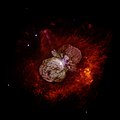Skeda:Eta Carinae.jpg

Madhësia e këtij shikimi: 600 × 599 pixel. Rezolucione të tjera: 240 × 240 pixel | 480 × 480 pixel | 769 × 768 pixel | 1.025 × 1.024 pixel | 2.015 × 2.013 pixel.
Dokument origjinal ((përmasa 2.015 × 2.013 px, madhësia skedës: 163 KB, lloji MIME: image/jpeg))
Historiku skedës
Shtypni mbi një datë/kohë për ta parë skedën siç ishte atëherë.
| Data/Koha | Miniaturë | Përmasat | Përdoruesi | Koment | |
|---|---|---|---|---|---|
| e tanishme | 18 dhjetor 2017 10:41 |  | 2.015 × 2.013 (163 KB) | The NMI User | Reverted to version as of 14:14, 1 May 2008 (UTC) |
| 13 mars 2017 15:45 |  | 3.000 × 2.998 (1,18 MB) | Leogorgon | larger file size | |
| 1 maj 2008 15:14 |  | 2.015 × 2.013 (163 KB) | Vol de nuit | {{Information |Description=(NASA News Release) A huge, billowing pair of gas and dust clouds are captured in this stunning NASA Hubble Space Telescope image of the supermassive star Eta Carinae. Using a combination of image processing techniques (ditheri |
Lidhje skedash
S’ka faqe që përdorin këtë kartelë.
Përdorimi global i skedës
Kjo skedë përdoret nga Wiki të tjera në vijim:
- Përdorimi në da.wikipedia.org
- Përdorimi në en.wikipedia.org
- Star
- Eta Carinae
- Wikipedia:Selected anniversaries/March 11
- Wikipedia:Today's featured article/March 2017
- Wikipedia:WikiProject Wikipack Africa Content/Wikipedia:Showcase
- Wikipedia:WikiProject WikiFundi Content/Eta Carinae
- Wikipedia:Today's featured article/requests/Eta Carinae
- Wikipedia:Today's featured article/March 12, 2017
- Wikipedia:Main Page history/2017 March 12
- Wikipedia:WikiProject WikiFundi Content/Wikipedia:Showcase
- Wikipedia:Main Page history/2022 March 11
- Wikipedia:Main Page history/2022 March 11b
- Wikipedia:Main Page history/2023 March 11
- Wikipedia:Main Page history/2023 March 11b
- User:2003 LN6/sandbox/Eta Carinae variable
- List of luminous blue variable stars
- Përdorimi në en.wikiversity.org
- User:Marshallsumter/Radiation astronomy2/Visuals
- User:Marshallsumter/Radiation astronomy2/Violets
- Stars/Astronomy
- User:Marshallsumter/Radiation astronomy2/Violets/Quiz
- Stars/Sun/Astronomy/Quiz
- User:Marshallsumter/Radiation astronomy/Courses/Principles/Hourly 2
- User:Marshallsumter/Radiation astronomy/Courses/Principles/Final quiz
- Draft:Original research/Io/Quiz
- Titan/Quiz
- Stars/Solar systems/Quiz
- Moon/Quiz
- Earth/Quiz
- User:Marshallsumter/Radiation astronomy/Colors/Quiz
- Volcanoes/Io/Quiz
- Stars/Violets
- User:Marshallsumter/Radiation astronomy2/Stars
- Stars/Violets/Quiz
- Përdorimi në es.wikipedia.org
- Përdorimi në fr.wikipedia.org
- Përdorimi në hi.wikipedia.org
- Përdorimi në it.wikibooks.org
- Përdorimi në la.wikipedia.org
- Përdorimi në mk.wikipedia.org
- Përdorimi në ms.wikipedia.org
- Përdorimi në my.wikipedia.org
- Përdorimi në oc.wikipedia.org
- Përdorimi në ru.wikipedia.org
- Përdorimi në sk.wikipedia.org
- Përdorimi në sr.wikipedia.org
- Përdorimi në th.wikipedia.org
Shikoni më shumë përdorim global të kësaj skede.
